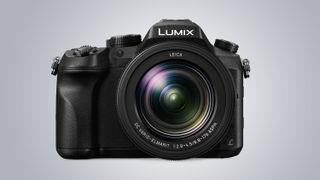Why you can trust TechRadar
Performance
- 12fps burst shooting (50fps with electronic shutter)
- 5-Axis Hybrid O.I.S system
- 2.36 million-dot Live View Finder
The FZ2500 / FZ2000 is capable of shooting at 12fps continuously, although this drops to 7fps should you want the autofocus system to keep a lock on moving subjects. When using the electronic shutter, however, it’s possible to boost this to 50fps at the camera’s maximum resolution.
Battery life is rated at around 350 images when using the LCD and 270 images when using the viewfinder, although you can typically extend it by adjusting your power management settings. Helpfully, you can also charge the camera through its USB 2.0 port, which is great if you happen to be by your computer or if you’ve misplaced your charger. This is also handy for travel and holidays – ideal applications for the FZ2500 / FZ2000 – as you can travel without a bulky charger.
The camera’s five-axis image stabilisation system is clearly effective, and makes a significant difference to keep things steady at the telephoto end. Furthermore, the dual axis levelling function is perhaps one of the better systems of its kind, clear enough to show that the camera is level without posing an obstruction to details in the scene.

Another change Panasonic has made from the FZ1000 is an increase to the viewfinder’s magnification, from 0.70x to 0.74x (in 35mm terms). This places it at the same level as many compact system cameras and some DSLRs, and its performance is very good in both good lighting and more demanding conditions. Details are clear, while noise and artefacts are both low, and the feed is nice and fluid.
The new touchscreen on the FZ2500 / FZ2000 is a massive help too, particularly when you’re using the LCD screen for composition, and even more so when it’s pulled away from the camera and used down low or up high.
The screen is highly sensitive, which makes it easy to focus on subjects by touch, and its visibility in harsher light is better than expected – looking closely you can see that it's quite close to the outer panel, which helps to combat reflections. Its excellent sensitivity, however, is also something of an issue, in that it’s very easy to inadvertently move the focusing point, or select an option by simply brushing against it.
The sensitivity and protrusion of the viewfinder’s eye sensor also mean it’s easy to deactivate the LCD screen when you’re using it, particularly when shooting at hip or ground level. You can reduce the sensor's sensitivity a touch through the menu, though, and this helps a little.

One of the main impressions you develop through use is just how responsive the FZ2500 / FZ2000 is in a range of situations. For example, even though you have to wait a brief moment for the lens to fully extend upon powering it up, the camera is ready for action with very little delay.
Browsing through the menus reveals no lagging, and with the right card in place shot-to-shot times are very good too. The touchscreen is slightly less responsive to pinching than anticipated, although it responds well to double-tapping.
Image quality
- In-camera raw processing
- +/-5EV (in 1/3EV steps)
- 4K DCI and 4K UHD video recording
The fact that the FZ2500 / FZ2000 appears to use the same sensor as the FZ1000 means we have a rough idea of what to expect in terms of image quality, although the new lens and any tweaks to processing will alter things slightly. In any case, the news is generally good.
The quality of video footage is very good, with a high level of detail and no particular artefacts evident. While the clarity isn't quite up there with the kinds of results we see from Panasonic’s Micro Four Thirds cameras, the FZ2500 / FZ2000 still does a very good job, and manages to suppress most noise in everyday footage.
The image stabilisation system helps to keep things calm at longer focal lengths, and rolling shutter is well controlled too. With the further advantage of reasonably clear audio, the camera can certainly produce great results here, with just a little manual intervention.

The FZ2500 / FZ2000's metering system doesn't appear to have any real issues, only occasionally leaning slightly towards underexposure, and otherwise performing well. Similarly, the Auto White Balance system manages to reproduce colours accurately under both natural and artificial lighting, and we was impressed by how faithful images looked at the default settings; you may want to intervene when capturing images in overcast conditions, though, as they can appear a little lacklustre otherwise.

Noise isn't problematic at the lower end of the sensitivity scale, and images generally retain their integrity well until around ISO1600 (as with the image above), where colour noise becomes more aggressive in shadow areas. Images are still usable at this setting, and indeed up to ISO6400, although how useable will depend on the subject, and on how you plan to output the images.
Detail is generally very good, and if you capture in raw you of course have greater scope for adjustment, although the breadth of control over in-camera JPEGs means it’s quite possible that you’ll be happy to rely on these for everyday shooting. Being critical, images do appear to lack the bite of those from the Sony Cyber-shot RX10 III, although that camera is admittedly more expensive.

It’s worth experimenting with the FZ2500 / FZ2000's noise reduction system if you’re in the habit of only capturing JPEGs; while some may find the default level a little heavy-handed, Panasonic does provide fine control over this if you want to make it less aggressive. If you're only using high-ISO images at smaller print or display sizes you may be perfectly happy with the JPEG options, but if you’re in any doubt, simply shoot raw images alongside and manually process out any noise.

It’s pleasing to find that optical aberrations, which are a particular concern for any camera with such a mammoth zoom lens, are largely absent from images. This is no doubt thanks to a combination of the camera's lens and processing prowess, with distortion corrected very effectively at the wide angle, and only traces visible further up the focal range. Vignetting is also minimal, as are chromatic aberrations, despite the latter being a little more visible at times.
Current page: Performance and image quality
Prev Page Build, handling and AF Next Page Verdict and competition
